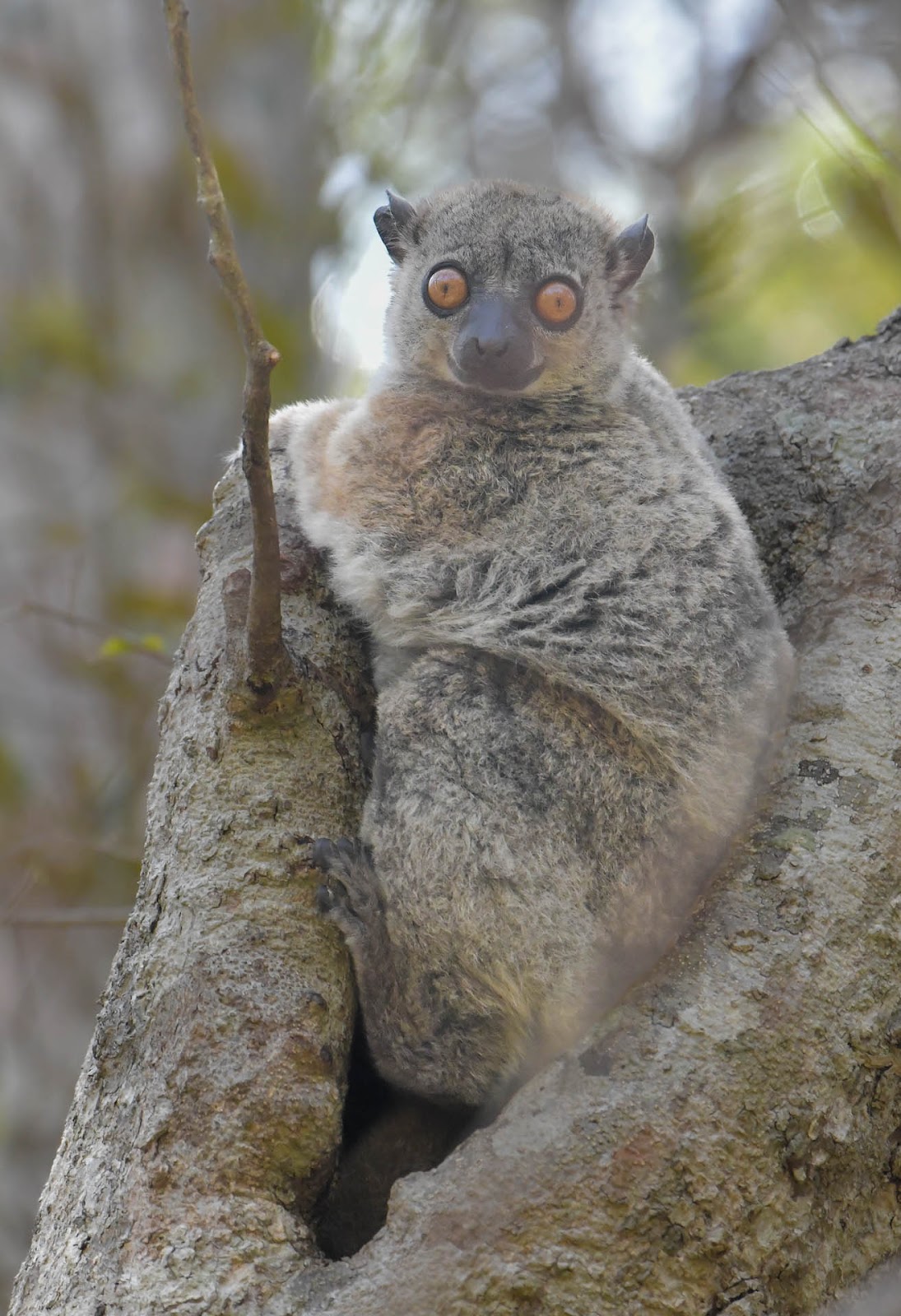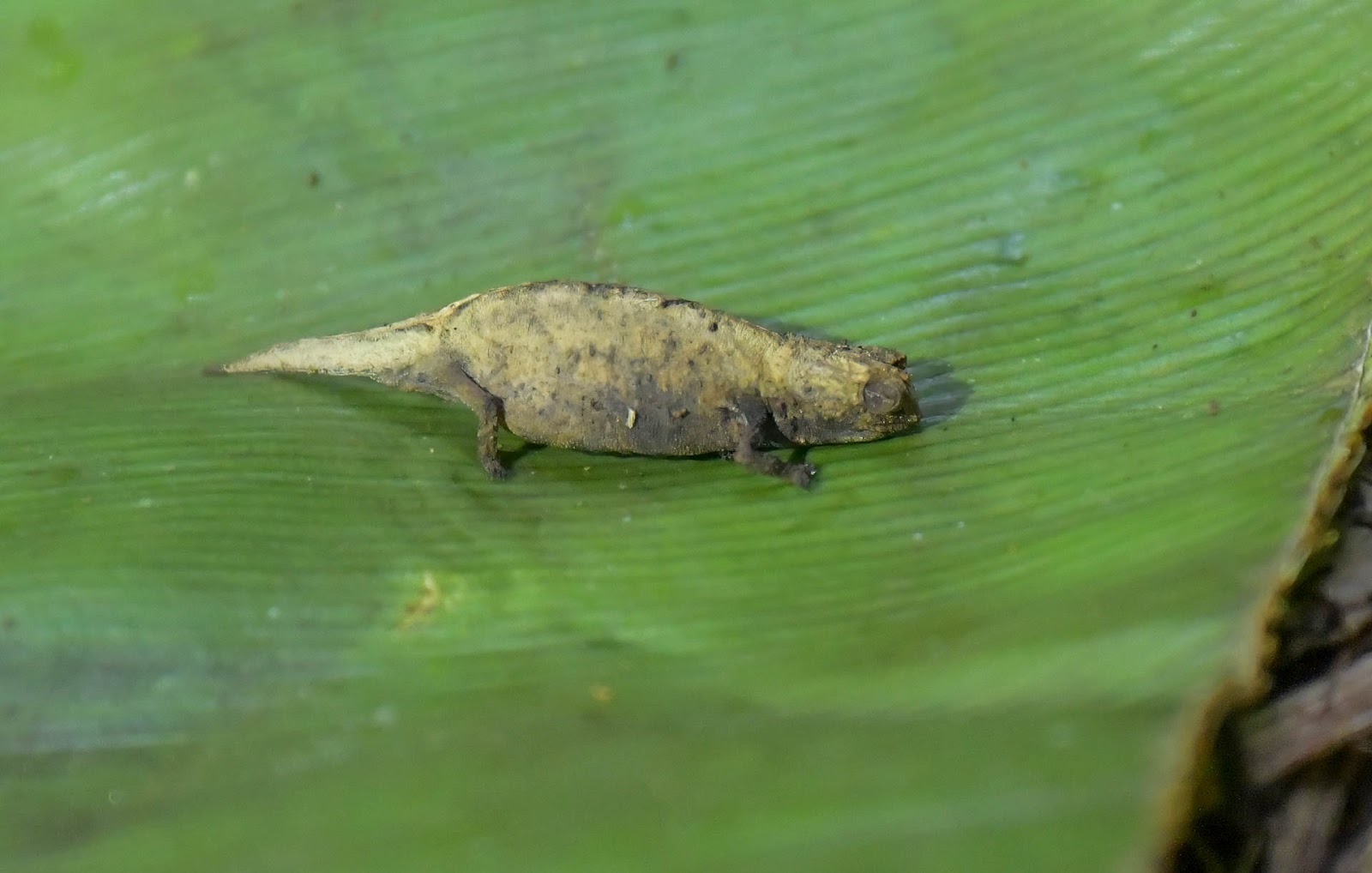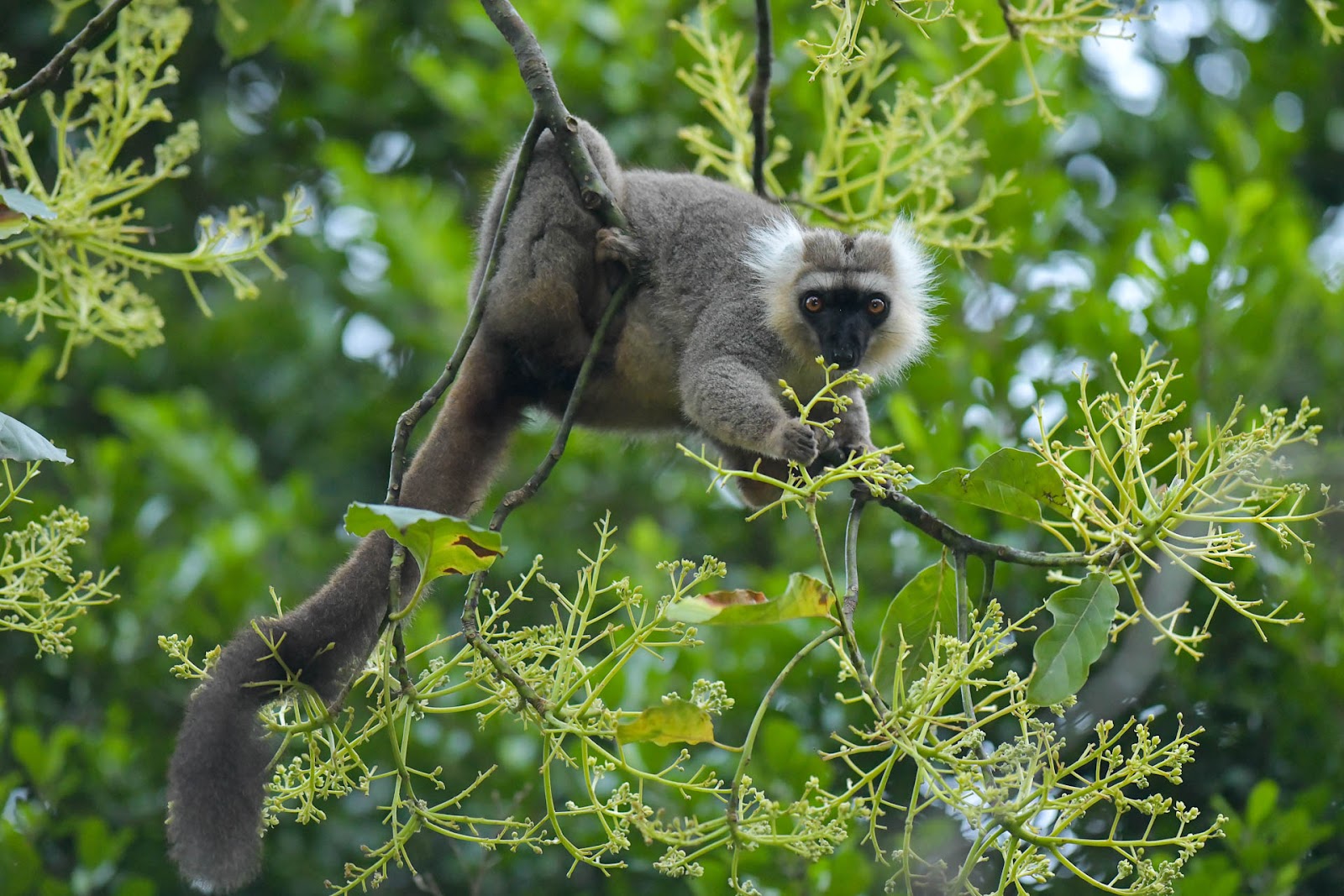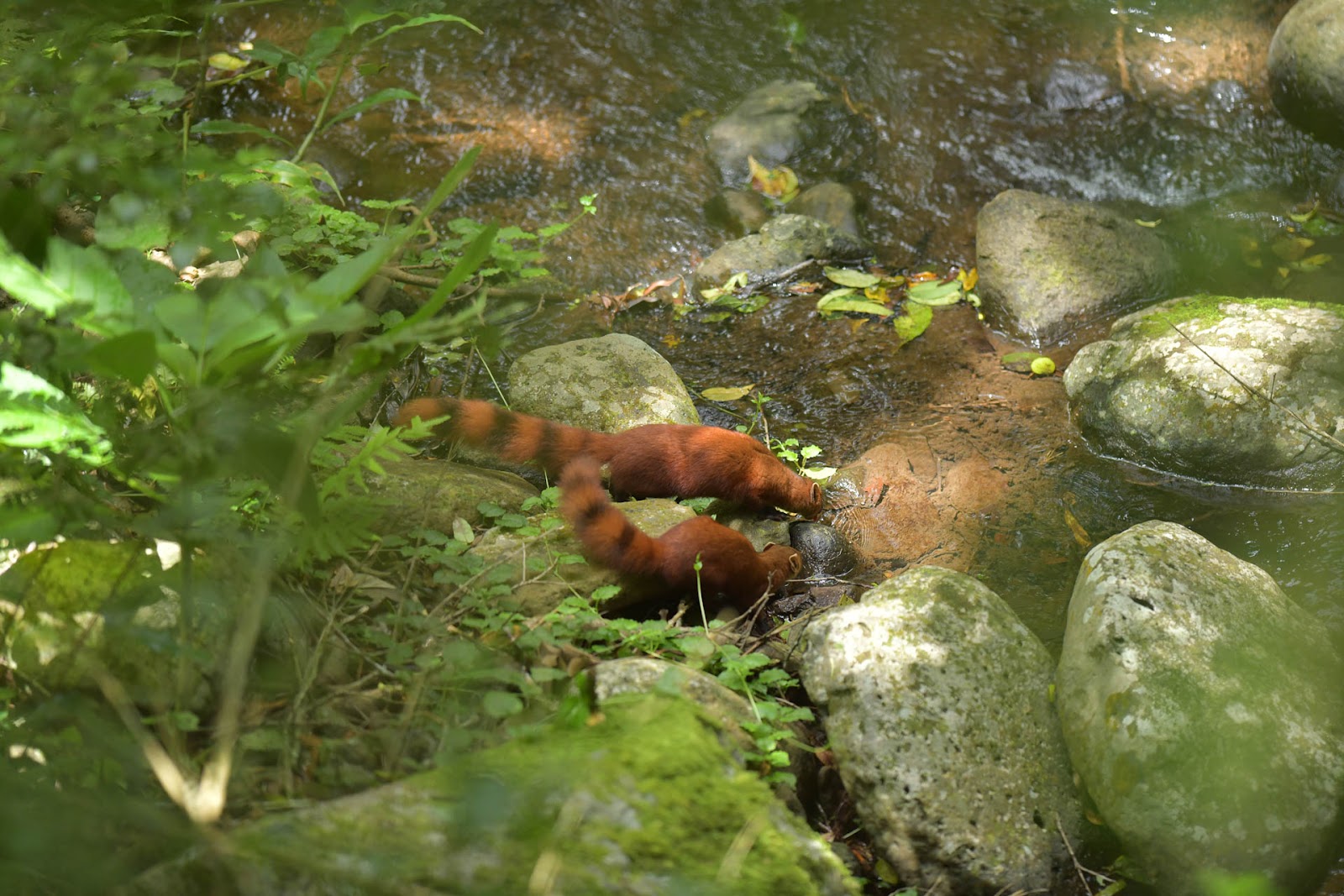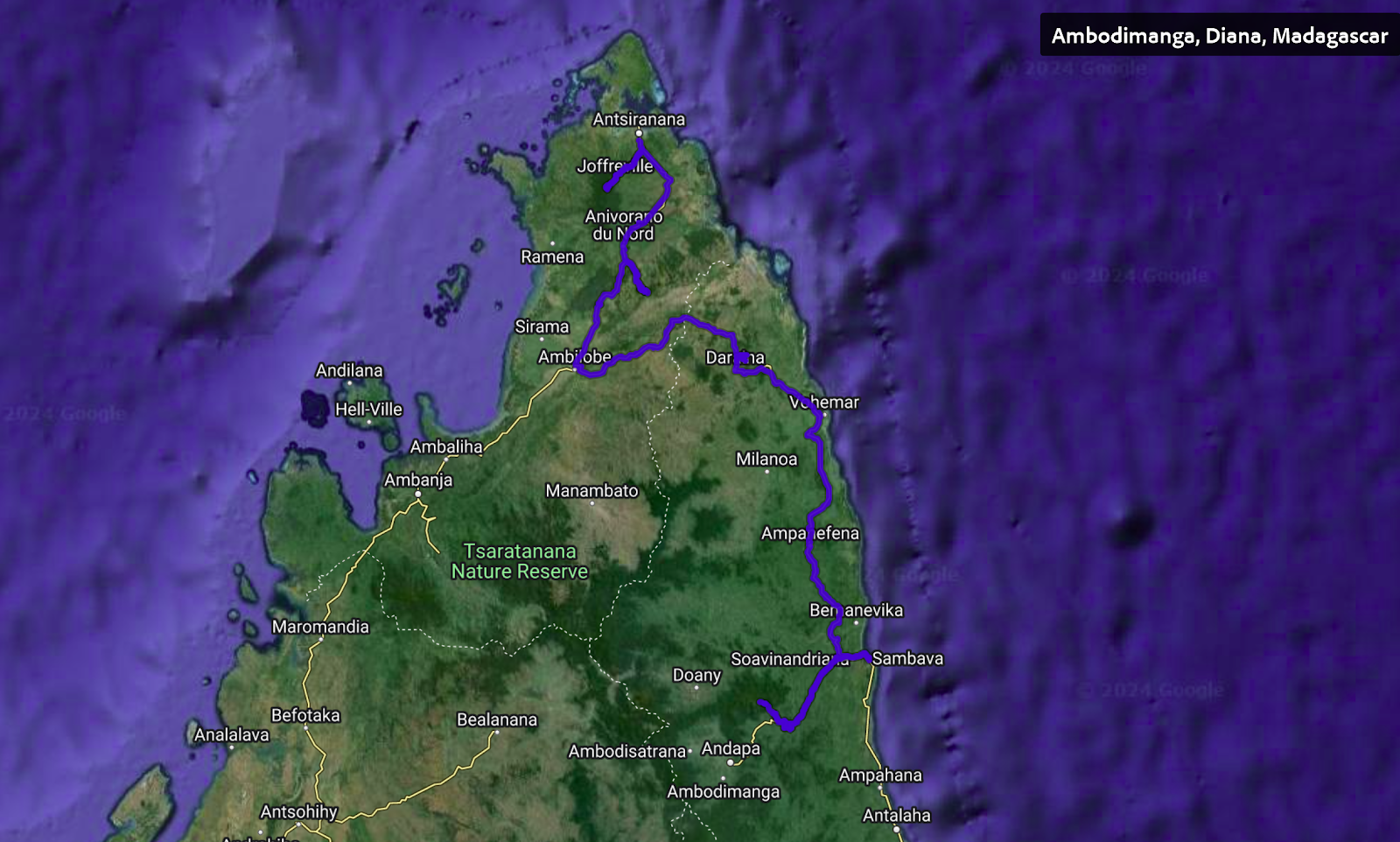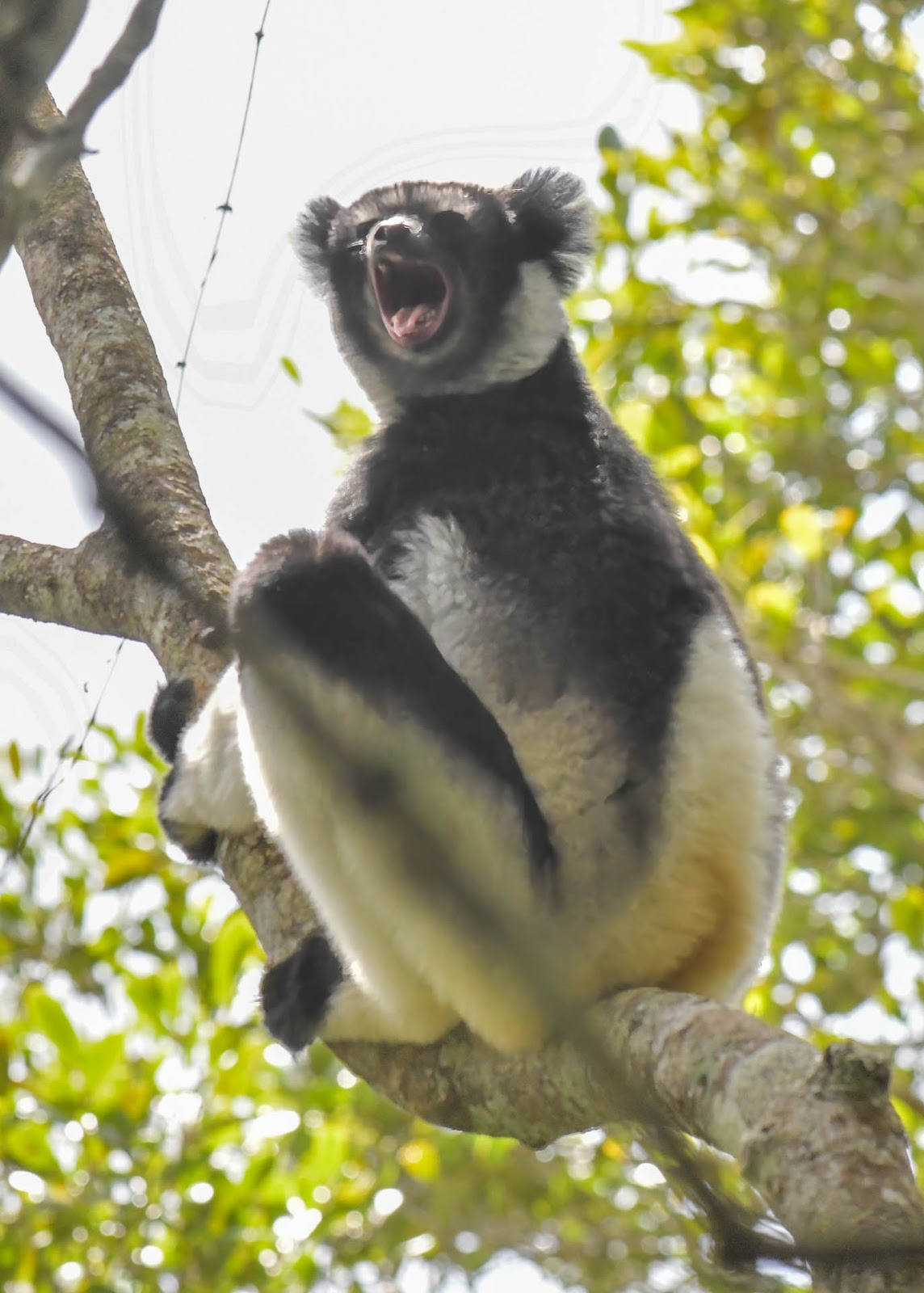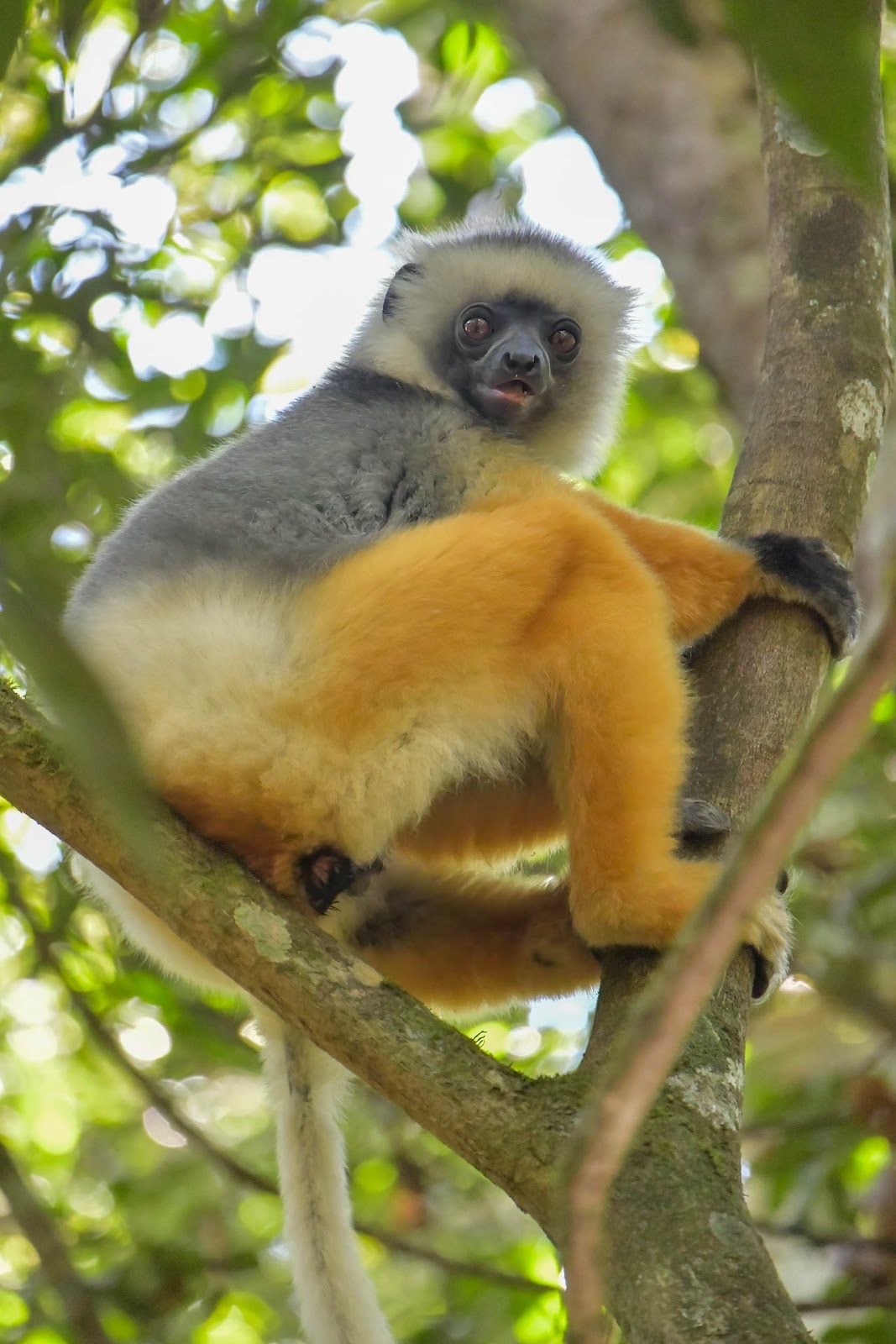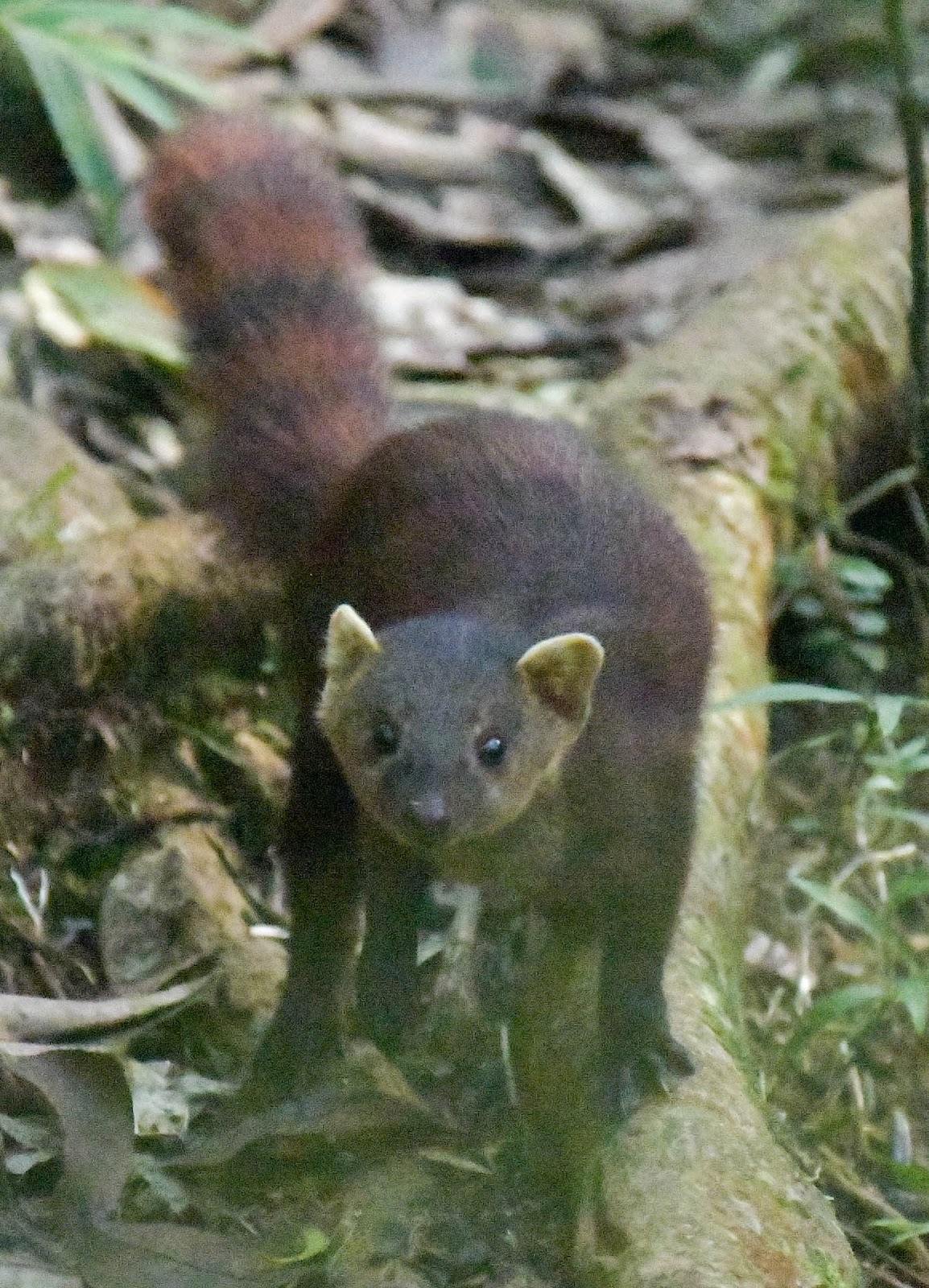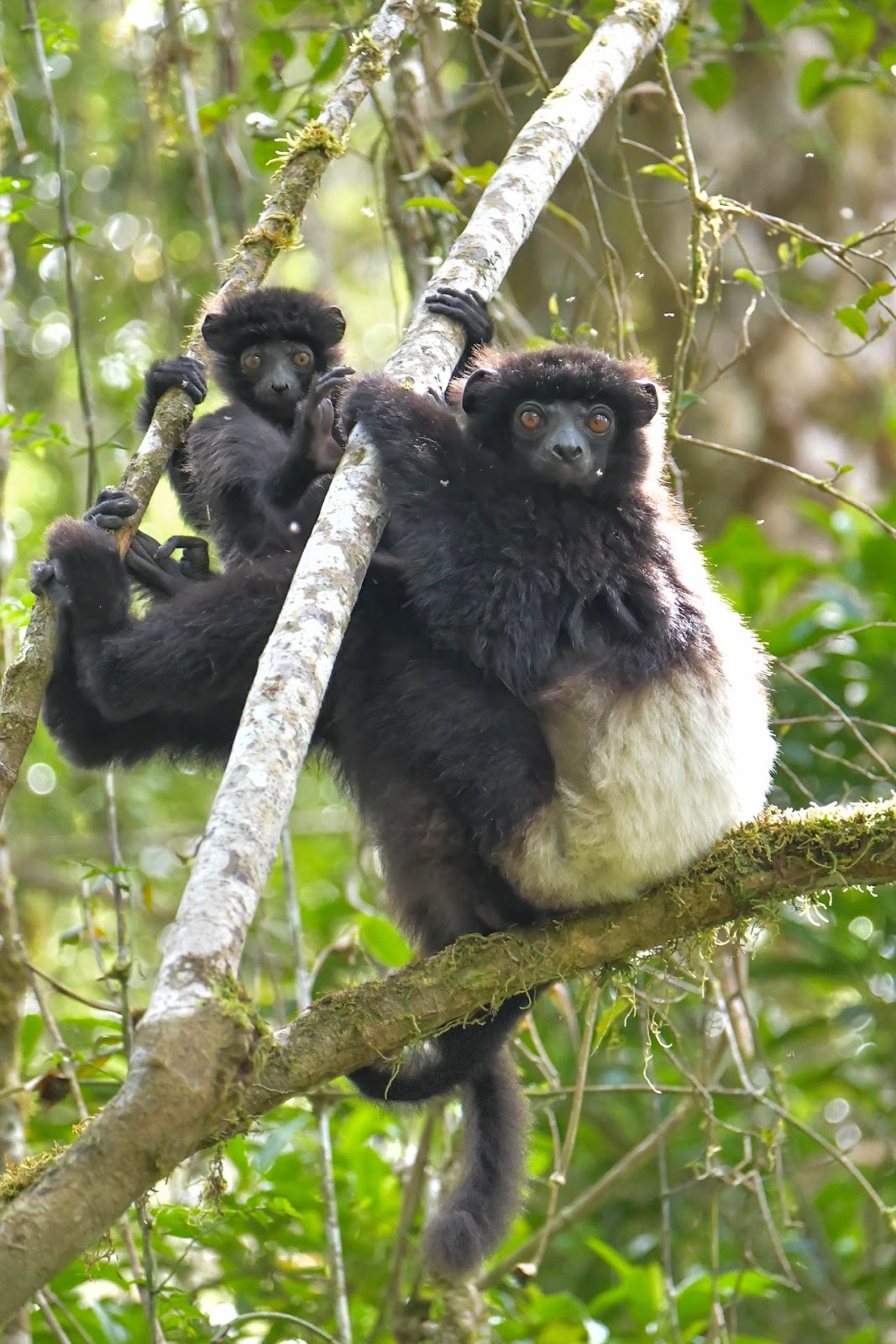We’re in the island of Madagascar with tour leader, Patrick Richard, searching for wildlife found nowhere else on the planet. Madagascar often dubbed the eighth continent, is a treasure trove of biodiversity and the final leg of our journey has brought us to the far north of the island. We flew from Antananarivo to Sambava early on the morning of Sept. 18 where we met our new driver Lee and piled into his minivan for the drive to Marojejy National Park. At the park headquarters, we met local guide Reese and cook Romeo, packed what we needed for the next 2 nights in the park, and drove to Manantenina Village for the start of our hike.
The first 2 km were past rice paddies and grazing Zebu cattle before we arrived at the park boundary. We entered a secondary forest and looked intently for lemurs but none were around. As we approached Camp Mantella, we glimpsed a Northern Bamboo Lemur in the dense vegetation but the White-fronted Brown Lemurs remained elusive. It was raining when we reached camp and settled into our basic cabin waiting for the weather to clear. A night walk around camp yielded a new lemur species for us, Mittermeier’s Mouse Lemur. One posed nicely on a wild banana flower with pollen on its face.
Early the next morning, we packed and headed up toward Camp Marojejia. A Northern Bamboo Lemur was feeding on a wild banana flower, the first time Reece had observed this behavior.
The weather had greatly improved and it was a pleasant walk through the rainforest. The trail steepened as we neared Camp Marojejia and had to use fixed ropes to scramble up some big rocks.
The camp had a nice view of a rock face of Marojejy Peak and Reece suggested we take a break but I was eager to see the Silky Sifakas. We continued steeply up about 300m above camp where we left the trail and bushwhacked our way through the thick vegetation to where a tracker had found a family of Silky Sifakas. The matriarch was sleeping in a tree and we got a good view of her when she lifted her head.
The rest of the family consisted of an adult male, 2 juvenile males, and an infant about two years old. The Silky Sifaka is one of the rarest mammals in the world! They exist in a very range-restricted area hence the effort to reach them was well worth it. We followed the family, no easy feat on the steep terrain but we got even closer and better views. One curious juvenile male approached us to within 100 meters!
 |
| Silky Sifaka |
Our encounter with the Silky Sifaka family was better than I had hoped. Our intrusion into their world caused minimal disturbance and provided the locals with much-needed income and a reason to protect these beautiful and rare animals!
Back at camp, Romeo served us a delicious lunch of salad and spaghetti bolognese. Two Ring-tailed Vontsiras showed up scavenging for leftovers under the kitchen hut giving us great views and photos.
At night the montane rainforest comes alive with herps including frogs, chameleons, and geckos. A pair of Madagascar Bright-eyed Frogs were mating in the creek below camp. The male is dwarfed in size by the female.
The Mossy Leaf-tailed Gecko is a master of disguise. When perched on a twig they blend in perfectly with their surroundings as they wait for unsuspecting prey.
 |
| Mossy Leaf-tailed Gecko |
September 20, our 37th wedding anniversary started early in the morning. I was hoping to see an Aye-aye, the most bizarre of all lemurs but we had a long journey to reach their location. It started with the long trek back to Manantenina Village where Lee was waiting for us. Along the way, Reese spotted a Helmut Vanga, the most sought-after target by birders in Madagascar! They nest here in the lowland rainforest and I was hoping we’d get a view of this spectacular bird with its distinctive blue arched bill.
Back at the park headquarters we retrieved our big duffels and set off for Sambava. An unexpected delay in town meant we wouldn’t leave until 2:30 in the afternoon and still had 4 hours to Daraina! Would we get to the Aye-aye site on time? Once they leave their nest to feed at night, they are nearly impossible to find. The race toward Daraina dodging Zebu along the way was on! Finally, in near darkness, we reached the turnoff where our local guide was waiting. He had found an occupied Aye-Aye nest in the morning but would it still be there? He rushed off to find out and we followed, losing him along the way. We managed to reconnect and got the bad news, the Aye-aye had left the nest and the guide was unable to locate it. We returned to the van crestfallen but made a new plan. We’d stick around Daraina the following day into the evening and drive to Ankarana Lodge after we had seen the Aye-aye. We drove to Camp Tattersalli where a large tent under a thatched roof had been set up for us. After dinner, we were too tired to go on a night walk and decided to call it a day. Not exactly the anniversary I was hoping for but one I’ll always remember!
As we were finishing breakfast the following morning, a family group of 10 Crowned Lemurs came to camp for a drink. We got close and had prolonged views as they came to the edge of the forest and crossed the road. Behind the caretaker’s hut, a yellow container with water had been set up on a platform for the lemurs to drink from. This species exhibits sexual dimorphism, females have a gray body with an orange crown and males are a darker reddish brown with a black and orange crown.
We entered the dry deciduous forest to search for two more lemur species that live here. Not far from camp, we found a family group of Golden-crowned or Tattersall’s Sifaka named after its discoverer, Ian Tattersall who first spotted this species in 1974. The Golden-crowned Sifaka was only formally described in 1988 and sadly today is listed as critically endangered.
The third lemur species that lives near Camp Tattersalli is actually a nocturnal species however, the caretaker knew the location of a day roost and we got great views of a Daraina Sportive Lemur.
Back at camp, we had lunch and the caretaker told us his son had located an occupied Aye-aye nest, yippee! This time we’d arrive at the location before dusk to wait for the Aye-aye to emerge. We drove to the same location as last night and proceeded on foot into the forest. As we got deeper into the reserve, I was surprised to hear many voices. Villagers from Daraina had set up makeshift camps inside the reserve to mine for gold! Many 20-foot-deep pits had been dug by hand and we had to carefully negotiate around them. Unfortunately, the Aye-aye nest was in the vicinity of a deep pit and as darkness fell we had to be especially mindful. A few curious villagers hung out with us as they had never seen an Aye-aye. Finally, under the cover of darkness, the Aye-aye emerged from its nest and began a long grooming session. Using its long middle digit, the Aye-aye gave his fur a thorough combing and finished the task by licking his shaggy coat. I’d never seen a primate groom in this manner, certainly more cat-like behavior.
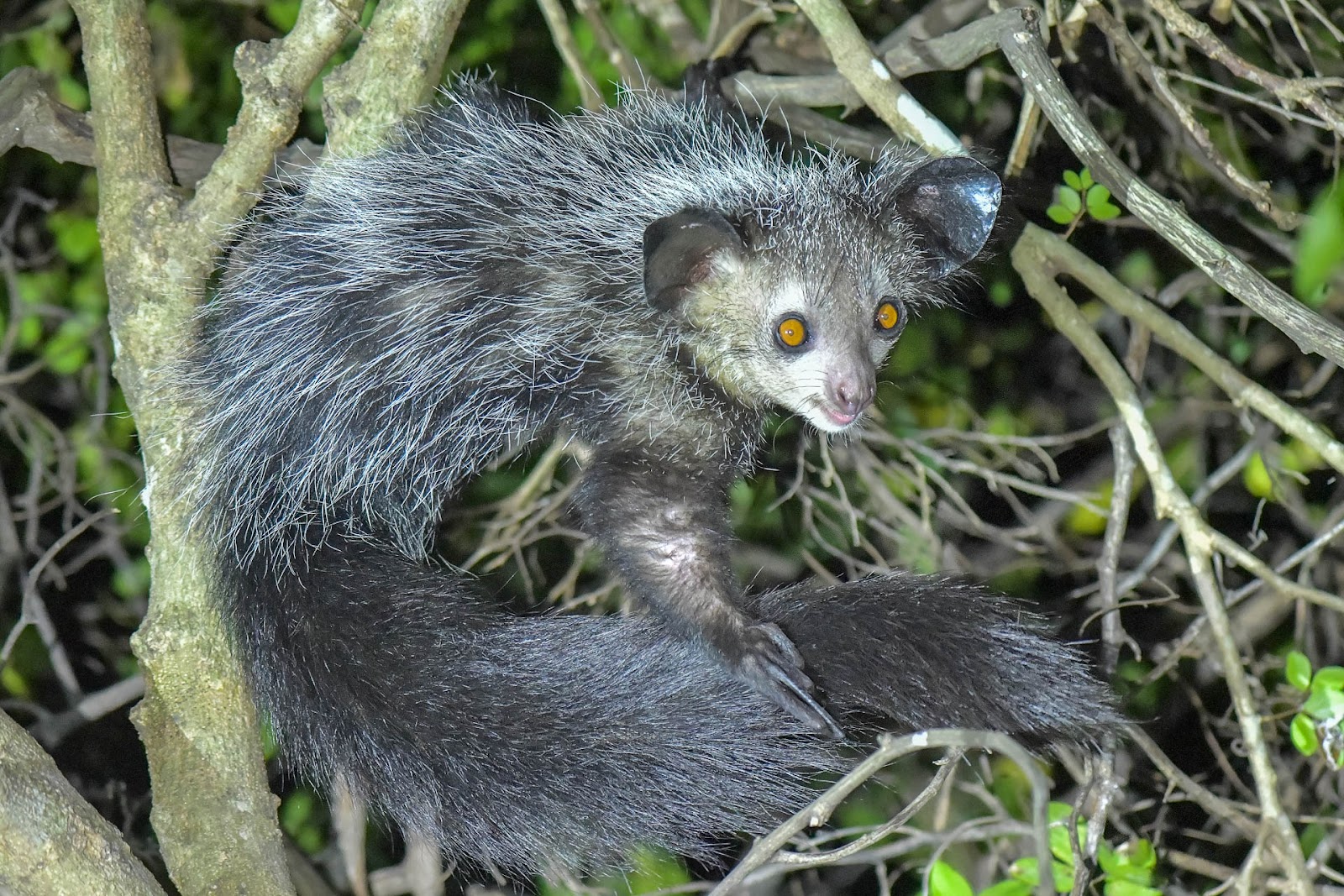 |
| Aye-aye |
Once presentable, the Aye-aye could start his nocturnal foraging using a technique called percussive foraging. First, the Aya-aye taps on trees to find grubs, then gnaws holes in the wood and uses its long middle finger to pull the grubs out. Only a few mammals use this foraging method more commonly employed by woodpeckers.
On the way back to our vehicle we encountered another nocturnal lemur species, the Tavaratra Mouse Lemur.
I was so happy that we had decided to spend a second evening in Daraina to see the Aye-aye, the most bizarre and ecologically interesting of all lemur species. Now, we had to make the long drive to Ankarana Lodge where we’d spend the night.
We left early the following morning for our next destination, the long-anticipated Akiba Lodge. This meant skipping Ankarana National Park and a chance to see the Ankarana Dwarf Lemur. We arrived at the Akiba Lodge run by Fanamby, a local non-profit, that encourages community-based ecotourism. After lunch, we set off to search the Analamerana Special Reserve, the last refuge for the critically endangered Perrier’s Sifaka. It took a bit of effort to climb the steep trails to reach the realm of the sifakas of which less than 500 exist in the wild. What a privilege to spend time with one of the rarest and most endangered primates in the world!
The reserve is also home to Crowned Lemurs (which we had seen), Sanford’s Brown Lemur, and Ankarana Sportive Lemur, two additional lemur species for us.
 |
| Ankarana Sportive Lemur |
The following morning we left Akiba Lodge for our final destination of the trip, Amber Mountain National Park. We checked into our accommodation, the Nature Lodge and had lunch before venturing into the park with our new local guide, Enyse. The forest is quite stunning with many bird nest ferns growing on trees over 100 feet tall. We didn’t find any mammals but saw many herps including Elephant-eared Chameleon (Calumma amber), Northern Blue-nosed Chameleon (Calumma linotum), Antakarana Leaf Chameleon (Brookesia antakarana) and Brookesia Tuburculata, the 3rd smallest chameleon in the world.
We caught a brief look at a Sanford’s Brown Lemur but other than that there were no mammals to be found even in the campground. The sun was getting low in the sky when Enyse spotted a group of 8 Sanford’s Brown Lemurs feeding on flowers in an avocado tree next to a park staff cabin. This was our closest and best view yet of this beautiful species.
By now it was getting dark, time for our night walk. No sooner had we started when a white pickup pulled up. The occupants told Patrick and Enyse that night walks are not allowed in the park which by the way closed at 5:00 pm. We had no choice but to leave, bummer! Enyse ran back to the campground to get Lee who was waiting there. In the meantime, I spotted an Arnhold’s Mouse Lemur high in a tree at the base of a bird nest fern.
We drove back to the park headquarters and started to spotlight from there. Amazingly, Marc and I were picking up a lot of eyeshine with our headlamps. The biggest surprise was a Montagne D’Ambre Fork-marked Lemur and Marc was able to get an amazing shot. Normally this species is found deep in the forest.
We also saw several Montagne D’Ambre Dwarf Lemurs.
So, despite being kicked out of the park, we found all 3 of our key nocturnal lemur species!
The next day we hiked to one of the crater lakes in the park. Enyse had seen a Falanouc, one of Madagascar’s rarest carnivores, along the trail in the past and we were hoping to get lucky. We staked out various points along the trail hoping a Falanouc would pass. Sadly, no Falanouc made an appearance today. Back at the campground, another one of Madagascar’s endemic carnivores was out in full force. We must have seen 5 Ring-tailed Vontsiras raiding picnic tables!
We returned to the Nature Lodge for our final official night of the tour. Tomorrow, we’d fly back to Antananarivo where we’d have to say goodbye to Patrick. What an amazing trip it’s been thanks to Patrick Richard, Haja, and Lee our drivers, and all our amazing local guides. Madagascar is truly a biodiversity Eden with so many plants and animals found here and nowhere else on the planet!
We hope all is well with everyone,
Peggy and Marc
Our route map:
- Fossa (Cryptoprocta ferox) KF
- Pale Fork-marked Lemur (Phaner pallescens) KF
- Gray Mouse Lemur (Microcebus murinus) KF
- Red-tailed Sportive Lemur (Lepilemur ruficaudatus) KF
- Western or Bastard Big-footed Mouse (Macrotarsomys bastardi) KF
- Verreaux’s Sifaka (Propithecus verreauxi) KF
- Red-fronted Brown Lemur (Eulemur rufifrons) KF
- Bokiboky or Narrow-striped Mongoose or Vontsira (Mungotictis decemlineata) KF
- Western Tufted-tail Rat (Elirus Mioxymus) KF (glimpse)
- Peter’s or Pygmy Mouse Lemur (Microcebus myoxinus) TNP
- Randrianasolo’s Sportive Lemur (Lepilemur randrianasoloi) TNP
- Decken’s Sifaka (Propithecus deckenii) TNP
- Rufous Brown Lemur (Eulemur rufus) TNP
- Ring-tailed Vontsira (Galidia elegans)TNP
- Bent-winged Bat (Miniopterus sp.) TNP
- Mauritian Tomb Bat (Taphozous mauritianus) TNP
- Madagascan Flying Fox (Pteropus rufus) TNP
- Giant Jumping Rat (Hypogeomys antimena ) KF
- Goodman’s Mouse Lemur (Microcebus lehilahytsara) VR, ANP, MR
- Lowland Streaked Tenrec (Hemicentetes semispinosus) VR
- Eastern Woolly Lemur (Avahi laniger) VR
- Indri (Indri indri) ANP, MR
- Common Brown Lemur (Eulemur fulvus) ANP, VR
- Diadem Sifaka (Propithecus diadema) ANP, MR
- Eastern Lesser Bamboo Lemur (Hapalemur griseus) VR & Ranomafana subspecies ranomafanensis
- Crossley's or Furry-eared Dwarf Lemur (Cheirogaleus crossleyi) ANP
- Madagascan Rousette (Rousettus madagascariensis) MR
- Black-and-white Ruffed Lemur (Varecia variegata) MR
- Red-bellied Lemur (Eulemur rubriventer) MR & RNP
- Weasel Sportive Lemur (Lepilemur mustelinus) MR
- Major's long-fingered bat (Miniopterus major) RNP
- Brown or Rufous Mouse Lemur (Microcebus rufus) RNP
- Spotted Fanaloka (Fossa fossana) RNP
- Small-toothed Sportive Lemur (Lepilemur microdon) RNP
- Groves’ and/or Sibree’s Dwarf Lemur (Cheirogaleus grovesi or sibreei) RNP (most likely)
- Golden bamboo lemur (Hapalemur aureus) RNP
- Greater bamboo lemur (Hapalemur simus) RNP
- Milne-Edwards’s Sifaka (Propithecus edwardsi) RNP
- Red Forest Rat (Nesomys rufus) RNP (P & P only)
- White-tailed Tree Rat (Brachytarsmis albicaudata) RNP
- Northern (Western) Gray Bamboo Lemur (Hapalemur occidentalis) MAR
- Silky Sifaka (Propithecus candidus) MAR
- Mittermeier’s Mouse Lemur (Microcebus mittermeieri) MAR
- Crowned Lemur (Eulemur coronatus) DAR & ANDR
- Golden-crowned Sifaka (Propithecus tattersallii) DAR
- Daraina Sportive Lemur (Lepilemur milanoii) DAR
- Daraina or Amber Mountain Fork-marked Lemur (Phaner electromontis) DAR & MdA
- Aye-Aye (Daubentonia madagascariensis) DAR
- Northern Mouse Lemur (Microcebus tavaratra) DAR & Andr
- Ankarana Sportive Lemur (Lepilemur ankaranensis) Andr
- Perrier’s Sifaka (Propithecus perrieri) Andr
- Sanford’s Brown Lemur (Eulemur sanfordi) Andr & MdA
- Amber Mt. Dwarf Lemur (Cheirogaleus andysabini) MdA
- Arnold’s Mouse Lemur (Microcebus arnholdi) MdA
Key:
LP = Lemur’s Park (captive)
KF = Kirindy Mitea National Park
TNP = Tsingy de Bemaraha National Park
VR = VOIMMA Reserve
ANP = Antisibe National Park
MR = Maromizaha Reserve
RNP = Ranomafana National Park
MAR = Marojejy National Park
DAR = Daraina
Andr = Andrafiamena Forest
MdA = Montagne D’Ambre
For a complete list of non-avian observations made during our trip, visit my iNaturalist journal post at:
Madagascar Tour, Aug. 28 - Sept. 28, 2023









